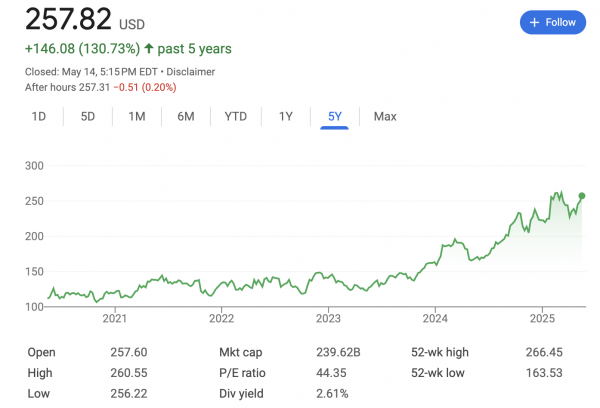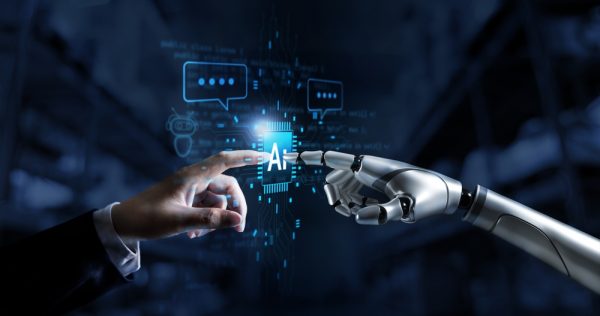It’s almost exactly five years since Arvind Krishna was elevated to CEO at IBM. Roughly 35 years since he joined the company in 1990. He’s led IBM research, IBM Cloud, and was a key force in the Red Hat acquisition. Last week at IBM’s annual Think conference he spent an hour taking questions from analysts about the state of IBM and, not surprisingly, mostly focused on its plans for AI.

AI writ large will wrought many things. Innovation to be sure, Workforce decimation, very likely. AI overlords, not-so-much says Krishna. In the war over model size – if it is a war – small will win for most organizations seeking to get into the game. Why does IBM (almost alone) persist in having a separate independent research organization?
Since taking over at CEO (April 2020), Krishna has worked to focus IBM, shedding less core functions, and betting big on a hybrid cloud and AI strategy. The company’s stock has risen dramatically (~130%), though perhaps predictably, not enough to please everyone. The S&P 500 index grew roughly 105% in the same period.

Presented here is Part 1 of Krishna’s answers to those questions posed by analysts at the lengthy Q&A session. Rather than repeat the questions, we’ll just note the topics. Part 2 will follow in the next two weeks. Altogether, Krishna’s comments provide a clear view of his ideas on why AI is important, what some of its major impacts will be, and how IBM is attempting to both drive and ride the AI wave.
Agree or disagree with Krishna – and he has plenty of fans and critics — his thoughts on AI’s future role make fascinating reading.
1 What’s AI’s Impact on Innovation
I think we’ll give you a multi layered answer. First, put aside AI as a market. How do you apply AI inside to improve innovation? I think this is something that everybody ought to understand. This is mostly a question of the speed and cost of innovation. I think I see AI directly providing — if I look at a two-year picture — anywhere from 30% to 60% improvement in the speed and cost of doing innovation. I hear people talking about 80 to 90%. I think that’s a bit of a stretch, at least in technology. We see 10% already in terms of pure programmer productivity across the board. When I measured across 5000 people, I think that 10 goes to 20% once I include test cases and requirements, and [it] goes to 30% with just improvement in these capabilities over the next two years.
[Also,] we should never forget the innovation that sits inside many, many different functions. How about procurement? How about accounting? I easily see those kinds of numbers in that range that’s in there. The third and final, of course, is we want to be an AI provider for people. We want to help them become more and more innovative. Now, it’s not really a savings now. It’s a cost of building those capabilities. Like some of the things we announced this morning, we’re going to lean in very heavily. I think AI models, especially smaller models. I think there’s a lot of opportunity for those. I think agents and our people use them. There’s a lot of opportunity for those, but that’s going to be an investment, not a not a savings like the for the first two; that’s why, I’m sorry, [I say there are] three different layers, and all three apply — the first two help in giving us money that we’re going to pull into bucket three.
2 AI Destroys Job, Ruins Economy…But Fuels Rebirth

Let’s take a simple example. Let’s take mechanization of farms. 1900, if I remember the number right, 47% of the US labor force directly worked on a farm. By 1960 that number was 3% maybe around the same, maybe even lower. Now I didn’t bother to go further. So mechanization, as in, combines, harvesters, tractors, all of those things dropped the 47% to 3%. The doom and gloom. People turn around and say, oh my god, 45% of all jobs were lost. [That’s] completely BS. I mean, the total number of jobs only increased in that time period. But these things didn’t exist in 1900 and did exist by 1960. Restaurants and fast food together, about 15% of all jobs. The whole automobile industry and the appropriate service industry around that.
Why? Because, as time got filled up, people now had the option to do leisure activities, go to restaurants. As productivity increased, they had the money to go and do all those things. And so to me, this is the same exact that is going to go on here. I mean, I’m 100% sure when the steam engine came on, I’m guessing that people who were horses and oxen felt their livelihood would go away. So there is displacement, total employment increases, but there is displacement.
So let’s take IBM. I’m pretty open about it. I think that there’s about 20,000 which is about 8% of our (IBM workforce) total, which I think there will be displacement. Now we do offer a lot of upscaling and rescaling. Can all of those people be able to take advantage of that and emerge in a place inside us. I think that’s only a third of those people. I’ll be straightforward. At least 14,000, what happens to them? Well, we churn about 15,000 people a year. That’s just average year, that number of people leave us either to retire or to go to other places or go do other things. So I think at the numbers and scale we’re talking about between re-skilling and just churning, you can absorb those things.
I think there’s a bigger societal question [that] should be asked. Jobs that require critical thinking will very much be in demand, jobs that require creativity will very much be in demand, but a lot of good jobs [will be eliminated]. But this has been, I mean, I’m sorry to say it this way but I think that’s been the nature of progress for the last 300 years, that jobs which can be automated tend to get automated away. Now the question is, what are those people going to do who did those kinds of jobs? They’re not going to have those jobs here. Let’s just be straightforward. But are there other jobs for people like that? I think those are another data space. I think I’ve always been of the opinion that I think that elderly care is a big topic. If a third of our population is going to be over the age of 65 — it used to be five to 10 — If it’s a third, that’s a massive amount of a service in that.
3 Managing Human and Digital Workers will be the Norm
 So I’m one of the people who believe that AI becoming autonomous and taking it over [like] Skynet is ludicrous. But are there going to be a lot of digital workers alongside the human workers? I think that we’re going to be managing populations where the number of digital workers, outnumber human workers ten to one. So the point that you’re asking at a more serious level, I think, for the next three to five years, it is a deep understanding of how do these two augment each other, and how do they make the human a lot more productive?
So I’m one of the people who believe that AI becoming autonomous and taking it over [like] Skynet is ludicrous. But are there going to be a lot of digital workers alongside the human workers? I think that we’re going to be managing populations where the number of digital workers, outnumber human workers ten to one. So the point that you’re asking at a more serious level, I think, for the next three to five years, it is a deep understanding of how do these two augment each other, and how do they make the human a lot more productive?
Where people often go wrong on being scared is if you make the human more productive, then the nature of the world has shown us that those people will actually command a lot higher wage and a lot better life, but they need to be able to work with their digital workers and that will be of incredible value. I mean, the same is true in our [IT] industry. I mean it’s going to maybe somewhat similar in journalism. People who use an AI system to very quickly scrape what may be in a company’s earnings release are going to be more valuable [at first] but then, if they can put it in context with other companies and other knowledge and what the industrial trends are, that’s incredibly more value than the people who are originally just scraping the release to give you the basic facts.
Do I believe that we’re going to be managing both? Absolutely. Do I believe that the people who talk about the company of one, where it’s all digital workers and there’s no humans, I think that’s a bit far-fetched. I always tell our people in the field, people who are directly marketing inside the clients, taking the information of what we have for the client, could we put an AI agent do that? Of course. But the empathy of understanding what motivates a particular human being, what is the structure and what is the incentives inside a particular client, what are the exact gaps today — I don’t think AI is going to get there in the next 10 years. That’s very much the human who’s in front of them understanding what appeals today versus what will appeal maybe a year from now. That’s very much, I think, still a human task.
4 IBM’s BIG Bet on Smaller Vertical Models
I mostly believe there will be a ton of domain specific models. And almost by definition, a domain specific model will be a small one. If it’s a lot, then it’s not domain specific. It just happens to be able to go across many different domains, and then you have to say, well, running it is the same cost and it’s equally power efficient. But I’m sorry that breaks the laws of both physics and computer science, because the [model that] is 100 times the size is going to probably cost you 10,000 times more energy and compute cost to run it. So I think economics drives you to say, if you’re doing specific domains, it’s much better to be small than large.
Number two, I think the problem set leads itself to small, not large models. If I’m worrying about corrosion in pipelines, how much data am I going to get that I draw upon. So it’s going to it’s going to lead you towards a much smaller data set, which means that it makes sense to have a smaller model. And three, if people want to augment a base model, let’s say big or large, with their own data. Their own data, by definition, is small. What do you gain from going from large refined model to another large model, if a smaller model can ingest all your data, which is the value to the enterprise. So that’s why I got to argue that there is a world for small.
But I was very careful to say I think there will be space for…I don’t know whether it’s three, four, or a dozen very large models. I do think there will be space for that. If I’m building a consumer app and I want to be able to answer questions, maybe for the current or the next generation of search, I can’t predict what people are going to ask. In that case, the one who builds the wider model actually has a business and fundamental advantage. They don’t mind the cost and the energy use of that because they win if they have a total larger base of people who use it.
So I think there will be space for, let’s call it a dozen of those. Those will cost you $1 billion, $10 billion, maybe $30 billion to go build, and they have a role to play. Then there will be space for 1000s of the domain specific smaller models. And if you go into the enterprise, there’s 6 million enterprises. Half the spend is in the top 2000 so suppose we just stop it there. These 2000 will guarantee, in the next five years, have enough models that are proprietary to that. So there’s a space for 10,000-to-20,000 small models.
[Q: Will IBM app store have verified models/] Well, I always like to experiment before coming to a conclusion. So the fact that we put an agent catalog in what’s the next orchestrate [watsonx Orchestrate], and we put 150 agents, and we had people calling us wants to find out about it, to get their agent in there. Did I answer [your question] through action rather than words?
Editor’s note: Look for Part 2 which will examine how IBM consulting will be affected by the AI revolution; what Krishna says are his biggest challenges; and more.

